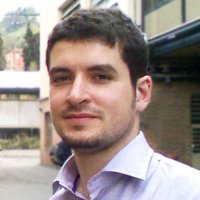Invited Talk by Federico Tombari: Detection of objects and structures of interest using shape information
Detection of objects and structures of interest using shape information
The talk will illustrate current techniques for the task of detecting objects and structures of interest in visual data under a variety of challenging conditions, focusing on the use of shape information. Initially, it will introduce state-of-the-art representations for 3D data enabling matching and correspondence estimation between point clouds and 3D meshes. These representations will be successively deployed for the task of 3D object recognition in clutter and 6-Degree-of-Freedom pose estimation. The talk will also discuss the related aspect of automatic detection of structures of interest in 3D outdoor data acquired with Lidar sensors. Finally, it will introduce texture-less object detection from images, together with a recent technique aimed at tackling such problem.
Bio
Federico Tombari (
homepage) holds an appointment as an Assistant Professor at the University of Bologna, after obtaining from the same institution a Ph.D in 2009. His current research activity concerns computer and robot vision, and it encompasses co-authoring more than 50 refereed papers on peer-reviewed international conferences and journals, mainly focused on visual data representation, object recognition, stereo vision, video analysis for surveillance and 3D perception. In 2004 he has been visiting student at University of Technology, Sydney, while in
2008 he has been an intern at Willow Garage, California. He is a Senior Scientist volunteer for the Open Perception foundation and a developer for the Point Cloud Library, contributing also in terms of dissemination and mentoring for code sprints sponsored by private companies (Google, Trimble, Honda). In 2014 he serves as administrator and mentor for PCL in the Google Summer of Code. He is member of IEEE and IAPR-GIRPR. He is the recipient of the "Best Paper Award Runner-up” of the International Conference on 3D Imaging, Modeling, Processing and Visualization Technologies (3DIMPVT 2011).


